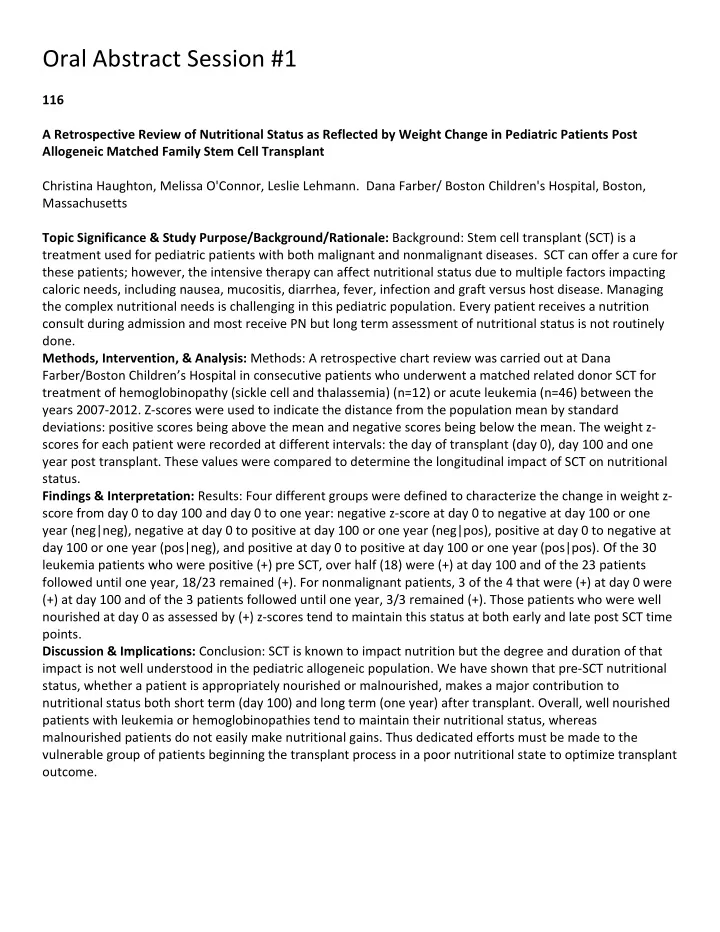

Oral ¡Abstract ¡Session ¡#1 ¡ ¡ 116 ¡ ¡ A ¡Retrospective ¡Review ¡of ¡Nutritional ¡Status ¡as ¡Reflected ¡by ¡Weight ¡Change ¡in ¡Pediatric ¡Patients ¡Post ¡ Allogeneic ¡Matched ¡Family ¡Stem ¡Cell ¡Transplant ¡ ¡ ¡ Christina ¡Haughton, ¡Melissa ¡O'Connor, ¡Leslie ¡Lehmann. ¡ ¡Dana ¡Farber/ ¡Boston ¡Children's ¡Hospital, ¡Boston, ¡ Massachusetts ¡ ¡ Topic ¡Significance ¡& ¡Study ¡Purpose/Background/Rationale: ¡Background: ¡Stem ¡cell ¡transplant ¡(SCT) ¡is ¡a ¡ treatment ¡used ¡for ¡pediatric ¡patients ¡with ¡both ¡malignant ¡and ¡nonmalignant ¡diseases. ¡ ¡SCT ¡can ¡offer ¡a ¡cure ¡for ¡ these ¡patients; ¡however, ¡the ¡intensive ¡therapy ¡can ¡affect ¡nutritional ¡status ¡due ¡to ¡multiple ¡factors ¡impacting ¡ caloric ¡needs, ¡including ¡nausea, ¡mucositis, ¡diarrhea, ¡fever, ¡infection ¡and ¡graft ¡versus ¡host ¡disease. ¡Managing ¡ the ¡complex ¡nutritional ¡needs ¡is ¡challenging ¡in ¡this ¡pediatric ¡population. ¡Every ¡patient ¡receives ¡a ¡nutrition ¡ consult ¡during ¡admission ¡and ¡most ¡receive ¡PN ¡but ¡long ¡term ¡assessment ¡of ¡nutritional ¡status ¡is ¡not ¡routinely ¡ done. ¡ ¡ Methods, ¡Intervention, ¡& ¡Analysis: ¡Methods: ¡A ¡retrospective ¡chart ¡review ¡was ¡carried ¡out ¡at ¡Dana ¡ Farber/Boston ¡Children’s ¡Hospital ¡in ¡consecutive ¡patients ¡who ¡underwent ¡a ¡matched ¡related ¡donor ¡SCT ¡for ¡ treatment ¡of ¡hemoglobinopathy ¡(sickle ¡cell ¡and ¡thalassemia) ¡(n=12) ¡or ¡acute ¡leukemia ¡(n=46) ¡between ¡the ¡ years ¡2007-‑2012. ¡Z-‑scores ¡were ¡used ¡to ¡indicate ¡the ¡distance ¡from ¡the ¡population ¡mean ¡by ¡standard ¡ deviations: ¡positive ¡scores ¡being ¡above ¡the ¡mean ¡and ¡negative ¡scores ¡being ¡below ¡the ¡mean. ¡The ¡weight ¡z-‑ scores ¡for ¡each ¡patient ¡were ¡recorded ¡at ¡different ¡intervals: ¡the ¡day ¡of ¡transplant ¡(day ¡0), ¡day ¡100 ¡and ¡one ¡ year ¡post ¡transplant. ¡These ¡values ¡were ¡compared ¡to ¡determine ¡the ¡longitudinal ¡impact ¡of ¡SCT ¡on ¡nutritional ¡ status. ¡ ¡ Findings ¡& ¡Interpretation: ¡Results: ¡Four ¡different ¡groups ¡were ¡defined ¡to ¡characterize ¡the ¡change ¡in ¡weight ¡z-‑ score ¡from ¡day ¡0 ¡to ¡day ¡100 ¡and ¡day ¡0 ¡to ¡one ¡year: ¡negative ¡z-‑score ¡at ¡day ¡0 ¡to ¡negative ¡at ¡day ¡100 ¡or ¡one ¡ year ¡(neg|neg), ¡negative ¡at ¡day ¡0 ¡to ¡positive ¡at ¡day ¡100 ¡or ¡one ¡year ¡(neg|pos), ¡positive ¡at ¡day ¡0 ¡to ¡negative ¡at ¡ day ¡100 ¡or ¡one ¡year ¡(pos|neg), ¡and ¡positive ¡at ¡day ¡0 ¡to ¡positive ¡at ¡day ¡100 ¡or ¡one ¡year ¡(pos|pos). ¡Of ¡the ¡30 ¡ leukemia ¡patients ¡who ¡were ¡positive ¡(+) ¡pre ¡SCT, ¡over ¡half ¡(18) ¡were ¡(+) ¡at ¡day ¡100 ¡and ¡of ¡the ¡23 ¡patients ¡ followed ¡until ¡one ¡year, ¡18/23 ¡remained ¡(+). ¡For ¡nonmalignant ¡patients, ¡3 ¡of ¡the ¡4 ¡that ¡were ¡(+) ¡at ¡day ¡0 ¡were ¡ (+) ¡at ¡day ¡100 ¡and ¡of ¡the ¡3 ¡patients ¡followed ¡until ¡one ¡year, ¡3/3 ¡remained ¡(+). ¡Those ¡patients ¡who ¡were ¡well ¡ nourished ¡at ¡day ¡0 ¡as ¡assessed ¡by ¡(+) ¡z-‑scores ¡tend ¡to ¡maintain ¡this ¡status ¡at ¡both ¡early ¡and ¡late ¡post ¡SCT ¡time ¡ points. ¡ ¡ ¡ Discussion ¡& ¡Implications: ¡Conclusion: ¡SCT ¡is ¡known ¡to ¡impact ¡nutrition ¡but ¡the ¡degree ¡and ¡duration ¡of ¡that ¡ impact ¡is ¡not ¡well ¡understood ¡in ¡the ¡pediatric ¡allogeneic ¡population. ¡We ¡have ¡shown ¡that ¡pre-‑SCT ¡nutritional ¡ status, ¡whether ¡a ¡patient ¡is ¡appropriately ¡nourished ¡or ¡malnourished, ¡makes ¡a ¡major ¡contribution ¡to ¡ nutritional ¡status ¡both ¡short ¡term ¡(day ¡100) ¡and ¡long ¡term ¡(one ¡year) ¡after ¡transplant. ¡Overall, ¡well ¡nourished ¡ patients ¡with ¡leukemia ¡or ¡hemoglobinopathies ¡tend ¡to ¡maintain ¡their ¡nutritional ¡status, ¡whereas ¡ malnourished ¡patients ¡do ¡not ¡easily ¡make ¡nutritional ¡gains. ¡Thus ¡dedicated ¡efforts ¡must ¡be ¡made ¡to ¡the ¡ vulnerable ¡group ¡of ¡patients ¡beginning ¡the ¡transplant ¡process ¡in ¡a ¡poor ¡nutritional ¡state ¡to ¡optimize ¡transplant ¡ outcome. ¡ ¡
Recommend
More recommend